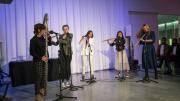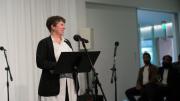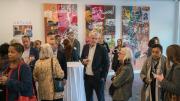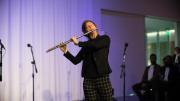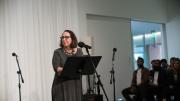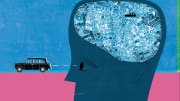“Artists, of course, need a room of our own,” Claire Chase, a flutist and professor of the practice of music, was saying to the audience gathered Thursday night to celebrate the opening of the $12.5-million Harvard ArtLab, a creative space in Allston dedicated to artistic collaboration across fields and disciplines. “We need to shut out the world sometimes. But I think we also need, more than ever now, places to gather and make noise together and ideate and argue and create a community.”
And with that, flute in hand as she stood in the ArtLab’s high-ceilinged, softly lit center room, Chase dove into the evening’s performance, beginning with a song that—appropriately, she said—was brand new, the ink still wet: “Echo,” by Brazilian-born composer Marcos Balter. While the notes from her flute bobbed and danced, accompanied by the electronics of musician Levy Lorenzo, four students playing triangles and chimes wafted about the room in what Chase called “a kind of sonic hug.” Afterward, singer Ganavya Doraiswamy, a Ph.D. student in music, performed “Ch 7: The Goddess,” a voice composition drawn from the Vimalakirti Sutra, an ancient allegorical Buddhist text, before Chase and the other musicians returned to play the night’s final number, “Five Empty Chairs” by Rosenblatt professor of the arts Vijay Iyer—a whirring collection of sounds involving five different flutes, from the contrabass flute that stood taller than Chase to a tiny wishbone-shaped ocarina.
It was an evening of thank-yous, congratulations, and brief, cheerful homilies on artistic boundary-crossing and experimentation. “This is a product of collaboration, meant to be a place of collaboration,” said former Harvard president Drew Faust, under whose leadership the ArtLab was conceived and pushed forward. She described the arts as a “special mode of learning and knowledge” that can “bring people together in ways that are so difficult in times like the ones we inhabit.”
President Lawrence S. Bacow spoke of the ArtLab as a means of engaging with the community beyond Harvard and as one element in the cluster of Harvard developments in Allston: a block away, the billion-dollar science and engineering complex is under construction; the American Repertory Theater’s (ART) new home will be built across the street; the 36-acre enterprise research campus is planned for nearby. Meanwhile, the ArtLab joins a collection of ventures with similar innovation ambitions: the Harvard i-Lab, the Launch Lab X, and the Pagliuca Harvard Life Lab.
Architect Frank Barkow, M.Arch. ’90, offered a few remarks about the design of the 9,000-square-foot building, which he described as a “hinge” and a “crossroads” that “encourages encounter and discourse” among artists and provides flexibility for new forms of creation, both predictable and unpredictable. “We designed this as a pinwheel around a one-story space,” he said. Encircling the ArtLab’s large central room—a multipurpose hub that can serve as a performance space (as it did Thursday evening), or a dance studio or screening area, gallery, or blackbox theater—are several smaller, more specialized spaces. There’s a fabrication workshop with a 3-D printer, band and table saws, and a laser cutter; a recording studio; a video-editing room; rooms for rehearsals and for collaborative conversations (and for individual work). A wide outdoor patio beside the building allows for warm-weather screenings or rehearsals, or can serve as an open-air paint studio.
A net-zero energy building—whose energy efficiency is intended as a model for future campus projects—the ArtLab is designed as a temporary structure with a 10- to 15-year horizon, “which I think some people have misunderstood,” Barkow said. “It’s not temporary in the sense that we would destroy it in 10 years, but in the sense that it’s a building that we could move to another location.” For now, in its current spot, the building “works as a kind of lantern,” he added, a nod toward its translucent skin. “It’s lit from the inside at night. It’s very beautiful.…It exists as a building with a particular identity on campus.”
If the exact nature of the artistic work that will take place inside remains a bit vague-sounding and murky, that’s partly because the place is intentionally wide open to possibilities. ArtLab director Bree Edwards describes it as “a messy space for the making” whose shape and contours will be defined to some extent by the artists who use it. In the months before the opening, the ArtLab invited several artists to come in for small experimentations: workshops, residencies, and collaborations—a kind of beta-test period. Among the pioneers were photographer and digital artist O.J. Slaughter; James Stanley, artistic producer in the theater, dance, and media concentration; ballet dancer and physicist Merritt Moore ’10; and artist and writer Dario Robleto (whose Radcliffe exhibition, Unknown and Solitary Seas: Dreams and Emotions of the 19th Century, opens in November). Egyptian-born artist Ganzeer used the space to create three large, colorful painted canvases for the ART’s production of We Live in Cairo last spring. Doraiswamy worked with Karthik Pandian, an assistant professor in Harvard’s art, film, and visual studies department, and choreographer Andros Zins-Browne, to develop vocal sounds and movements for an exhibition this fall in New York based on the story of a Syrian sculptor and refugee living in Brussels.
On Friday afternoon, the celebration continued with an open house that invited the public to tour the space and sample art and performances in progress: an “open rehearsal” by dancers from the Partnering Lab led by dancer and scientist Ilya Vidrin, a video installation by Hawaiian-born artist and Harvard Film Study Center fellow Andy Graydon, and a portrait studio where Slaughter was set up with cameras and lights, taking visitors’ photos. Lori Gross, associate provost for arts and culture, sliced into a cake in the shape of the ArtLab. “Instead of an official ribbon cutting, we have an official cake cutting,” Edwards joked, offering pieces on small plates.
A final day of the ArtLab opening celebration—this one pitched to the surrounding community—takes place on Saturday morning, with a performance at 10 a.m. by Subject:Matter, an Allston-based tap-dance group.
